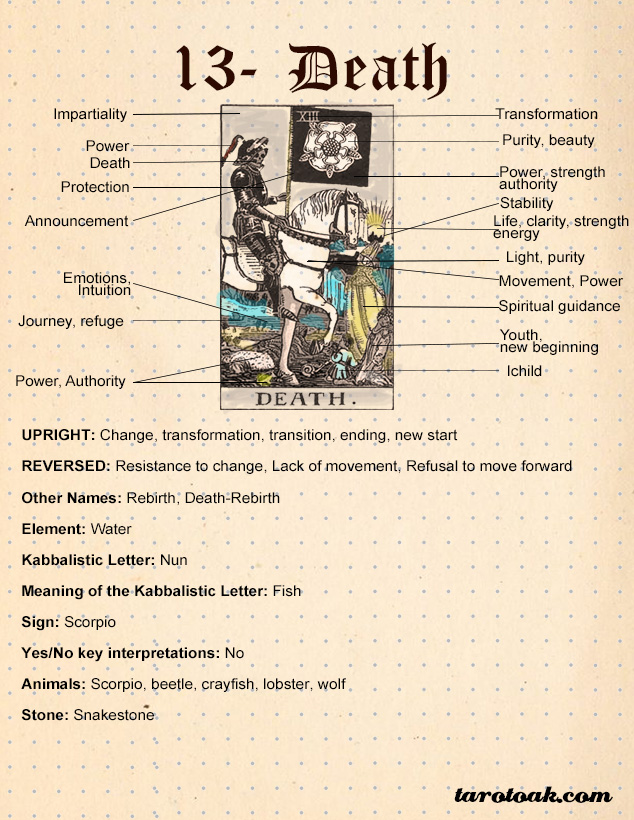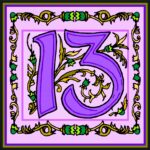The Death Tarot card, often met with trepidation, embodies profound transformation, heralding an inevitable yet auspicious metamorphosis. Far from the dread its name insinuates, this card invites introspection and essentially promises a renewal of perspectives. It serves not as a portent of physical demise but rather as a symbol of the end of one cycle and the inception of another; a compelling reminder that endings cultivate new beginnings.
At first glance, the imagery of the Death card can be startling. Traditionally illustrated through the figure of the Grim Reaper, cloaked in shadow and wielding a scythe, the representation is undeniably haunting. However, this spectral figure is not merely an omen of loss. Instead, it signifies the severance of old ties, outdated habits, and frayed beliefs that no longer serve one’s higher purpose. In an artistic juxtaposition, a setting sun may feature in the background, reflecting the finale of a chapter, yet also highlighting the emergence of dawn—hopeful and promising.
In the larger context of tarot, the Death card occupies the thirteenth position of the Major Arcana, a sequence that delineates the myriad stages of human experience and personal evolution. The numbers in tarot have significance; thirteen, often regarded as a numeral of transformation, underscores the transformative essence encapsulated within this card. Although the associations can lead to an eerie apprehension, understanding its underlying message unveils a liberating journey towards self-awareness and profound change.
Delving deeper, one discovers that the Death card evokes the principle of impermanence. In both life and the universe, everything is in a state of flux; nothing remains static for long. As one cycle concludes, another inevitably begins. This card implores the querent to embrace the transient nature of existence—to welcome change instead of shunning it. From the petals falling from a wilting flower to the cycle of day yielding to night, the essence of death and rebirth permeates every facet of reality.
When the Death card appears in a reading, it might invoke a wave of unease, albeit for good reason. The fear of change can be a formidable barrier, hindering growth and transformation. However, this card prompts one to reassess such fears. Are they rooted in comfort, or do they sprout from insecurity? The invitation here is to release obsolete elements, creating space for rejuvenation and novel opportunities.
Moreover, this card also accentuates the importance of detachment. Whether it is relinquishing toxic relationships, outdated career trajectories, or detrimental thought patterns, the Death card encourages a letting go. It is a visceral recognition that holding on too tightly can stifle progress. A butterfly trapped in its chrysalis may exemplify beauty, but it cannot soar until it breaks free from its confines. Hence, when Death manifests in a reading, it serves as a clarion call to shed that which encumbers the spirit.
The psychological implications of this card extend to the realms of personal development and emotional healing. Embracing change is a form of liberation. This metamorphosis can arise from various spheres—be it spiritual awakening, emotional recovery, or a significant life transition such as moving, changing jobs, or entering a new relationship. The Death Tarot card encapsulates the essence of rebirth; akin to the phoenix rising anew from the ashes.
Symbolically, the skeleton crowned with a laurel wreath epitomizes victory. It embodies the notion that through hardship and relinquishing the known, there arises an opportunity for triumph and rejuvenation. This reconciliation of oppositional forces—the end of a phase alongside the initiation of another—is not merely philosophical but rather a relatable experience echoing throughout humanity.
On a more pragmatic level, integrating the lessons of the Death card necessitates a fearless acceptance of uncertainty. It nudges individuals to step decisively into the unknown, to act with courage in situations where the familiar lapses into the unfamiliar. This risk-taking can open myriad opportunities that may have otherwise remained obscured, like hidden gems waiting to be discovered within the labyrinth of life.
Yet, the Death card does not limit its significance solely to personal transitions; its influence extends to broader contexts such as societal transformations and cultural shifts. This card can indicate a profound alteration within communities or relationships, urging a readjustment of norms, values, or systems. Through this lens, one can ponder on the societal fabrics that may fray and unravel, making way for progressive ideals to permeate consciousness.
Furthermore, the Death card speaks to the cycles of grief. Understandably, mourning is an intrinsic component of loss. This card acknowledges the pain associated with endings yet reassures that such grief can foster profound strength and wisdom. Embracing the temporality of existence allows for richer appreciation of life’s interconnectedness—the beautiful continuum that is inextricably woven with beginnings and endings.
In conclusion, the Death Tarot card, fraught with connotations of finality, ultimately champions an enlightening philosophy. It challenges one’s perceptions and calls forth the courage necessary to traverse the tumultuous waters of change. By confronting and embracing the end of certain phases in life, we afford ourselves the splendor of new beginnings. In the grand tapestry of existence, the Death card invites not fear, but curiosity—provoking a delightful inquiry into the hidden potential that resides in every transition. Thus, instead of shying away, delve into this card’s promise; there lies profound transformation and flourishing awaiting on the other side of transformation.








Leave a Comment